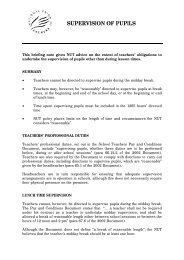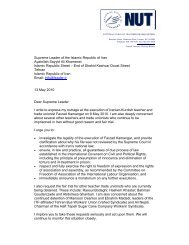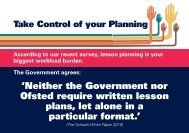Reducing Teachers' Workload â A Way Forward - National Union of ...
Reducing Teachers' Workload â A Way Forward - National Union of ...
Reducing Teachers' Workload â A Way Forward - National Union of ...
You also want an ePaper? Increase the reach of your titles
YUMPU automatically turns print PDFs into web optimized ePapers that Google loves.
It would be simple, thought one teacher, for OFSTED to set different levels <strong>of</strong> planning<br />
requirement for large and small schools respectively. It would also focus the minds <strong>of</strong> those<br />
in authority <strong>of</strong> the true advantages and disadvantages <strong>of</strong> small schools: most <strong>of</strong> the latter are<br />
overcome by the unremitting (and unacknowledged) personal effort <strong>of</strong> those who teach there.<br />
Overall workloads<br />
If indeed the teaching : marking/preparation ratio is nearer 1:1 than 2:1, this has important<br />
consequences for teachers’ working hours. For marking and preparation are not the only<br />
non-teaching requirements laid on teachers: there are also many meetings, parents’ evenings,<br />
etc. to attend (particularly in those schools where Heads are zealous about “requiring” 1265<br />
hours – see below). What does this mean for typical teacher working weeks ?<br />
Quantitatively, teacher working weeks have been tabulated extensively in the<br />
PricewaterhouseCoopers work already referred to. However it puts this work in context to<br />
list out three typical working patterns actually referred to by teachers in our sample:<br />
• 6:30 a.m. to 5:30 p.m. in school, plus two hours per night and most <strong>of</strong> Sunday (“the<br />
hour between 6:30 a.m. and 7:30 a.m., when most <strong>of</strong> my colleagues arrive, is<br />
particularly valuable. After then I am interrupted too <strong>of</strong>ten to get much done.”) 3<br />
• 7:30 a.m. to 4:30 p.m. plus two hours a night and weekends (“it seems like all<br />
weekend every weekend”) 4<br />
• 8 a.m. to 5 p.m. plus three hours per night (“I try and keep my weekends free – I’m<br />
not paid enough to get stressed.”) 5<br />
These patterns put flesh on the bones <strong>of</strong> what “sixty hour working weeks” actually represent.<br />
Finally, it should be noted that teachers feel they have little or no control over their<br />
workloads. It is this lack <strong>of</strong> control not just the number <strong>of</strong> hours that leads to stress. Several<br />
said that the only way they could make any space was in cutting down on lesson preparation<br />
and winging it. They alleged that cutting down on paper work under the current regime and<br />
especially for OFSTED was simply not possible (though see the discussion above). So if any<br />
short cuts are taken it is the quality <strong>of</strong> teaching that takes the hit.<br />
Holidays<br />
We specifically asked about patterns <strong>of</strong> working in holidays, as well as term time.<br />
3 Head <strong>of</strong> department, secondary school.<br />
4 Primary school class teacher.<br />
5 Secondary science subject teacher<br />
NUT/ATL 9 <strong>Reducing</strong> Teacher’s <strong>Workload</strong>
















